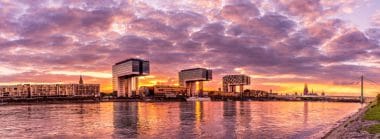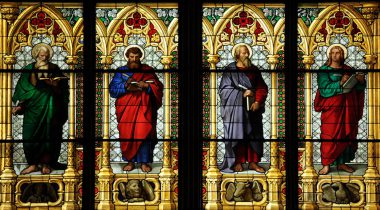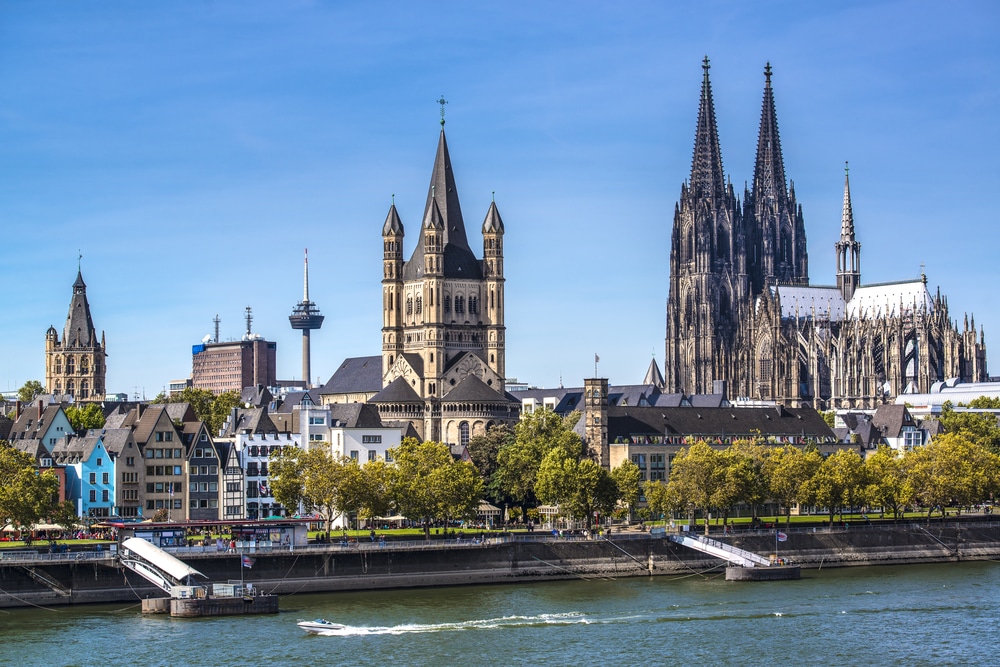Everything is a bit crooked and too small, the atmosphere Mediterranean-loud – light, casual and life-affirming. Cologne is not a chic Micki city, here it is down-to-earth. Churches, pubs, carnival – the three “Cs” have made the city famous. The wealth coupled with piety transformed Cologne into a major construction site immediately after the turn of the millennium. At that time, the numerous churches and monasteries were built, which earned the city the name “hilliges Coellen” and still dominate its silhouette today. The Rome of the North has a lot more to offer than the three glamorous “Cs”.
Cologne: “Do boes en Stadt met Liev und Siel”

Cologne – Where the stones make history
It was the Romans who wrote the first chapter of Cologne’s history. Cologne is the only one of the Roman foundations on the Lower Rhine to have retained outstanding and supra-regional importance over the millennia. For almost 2000 years, the city has always been a kind of capital. Not even the Vikings could change this when they also attacked Cologne in 881. Some things have been preserved from Roman times, such as the 14-metre-high pillar tomb of Poblicius and the Roman tower on Zeughausstraße. On the south side of the cathedral is the Roman-Germanic Museum, which opened in 1974. It houses important collections of ancient art and culture. On the Alter Markt, the historic town hall with a magnificent Renaissance vestibule bears witness to Cologne’s importance as a European metropolis of the Middle Ages. 124 figures from Cologne’s city history adorn the tower of the Gothic town hall. Attention: Every full hour, a creepy guy with a floppy hat sticks his tongue out at everyone. Directly in front of it, other historical epochs become visible – remains of the Roman Stadtholderpalast and the later Jewish quarter. Also just a stone’s throw away from the town hall on the banks of the Rhine is the mighty Romanesque Great St. Martin’s Church with the crossing tower and the striking cloverleaf choir. In addition, the Church of St. Mary in the Capitoline Hill and the Church of St. Peter are worth a visit. The most important early modern secular building in Cologne is considered to be the Gürzenich, built from 1441-47 as a merchant and festival house. This reflects bourgeois self-confidence.
Cologne Cathedral

It’s all in the mix – Dürer, Rembrandt and Picasso
The Rhine metropolis owes its wealth of museums to the great passion for collecting of its citizens. Cologne’s museums cover a wide range of topics. Institutions such as the Museum Ludwig enjoy a good international reputation for their holdings. The museum is known beyond the borders of the city and was named after the art collectors Irene and Peter Ludwig. In the immediate vicinity of the cathedral, it presents art from the beginning of the 20th century to the present day. Visitors can enjoy an impressive overview of the areas of drawing, painting, photography and sculpture. The focus is on works of Expressionism and the Russian avant-garde. Among other things, the oeuvre of Pablo Picasso is represented.
Media metropolis as superlatives
Cologne can look back on a long tradition as a stronghold of media companies. Art bookstores, printers and many magazine and newspaper publishers have been based in the Rhine metropolis for more than 100 years. Over time, a varied media landscape has been able to develop. The largest part of Cologne’s media industry is made up of radio and television companies. Cologne doesn’t just call itself the “Media City on the Rhine”, but is the European media hub and the TV capital of Germany .
The most beautiful districts and pubs of the Rhine metropolis of Cologne
The best pubs and neighbourhoods in Cologne – Cologne: Best Locations
If you want to get to know the people of Cologne from their open fawn side, you don’t have to wait until Carnival, where things are really great, especially on Shrove Monday. In each of the many pubs you can feel comfortable with them when the “Köbes” (waiter) serves the brown Kölsch. There is no doubt that Cologne is a city with a high recreational value. On their way to the countless restaurants and bars on the Rhine promenade, guests embark on a culinary journey around the world. The most urban district with the charm of a fashion metropolis is located in southern Norstadt-Nord. In the “Belgian Quarter” countless boutiques, small shops, cozy restaurants and great galleries invite you to linger. There is an incredible amount to discover. Why Belgian Quarter? Quite simply: the street names of the trendy district refer to Belgian provinces and cities. Ehrenfeld, probably the hippest district of Cologne, is no less inspiring. On weekends, the club landscape becomes one big party zone. Hip, multicultural and alternative – artists, nerds and families feel equally at home here.
Cologne is just “Kölle” – exciting, versatile and above all real! Cologne is exciting, versatile and above all real! Cologne is just “Kölle”
Tip: A look at the left bank of the Rhine, the “schäl Sick”, is also worthwhile. Here, the mighty neo-Romanesque building of the “Deutzer Domes” houses the Heribertschrein, probably the most valuable piece of the church treasure of the former Benedictine Abbey of St. Michael. South of Cologne lies Augustusburg Castle in Brühl, framed by a French garden with strict lines, surrounded by forest.
Cologne: The 7 most important sights
Cologne, one of Germany’s oldest cities, is known for its impressive history, vibrant culture, and iconic architecture.
The city on the Rhine offers numerous sights that attract millions of visitors every year.
Here are the top seven must-see sights on your visit to Cologne.
1. Cologne Cathedral
Cologne Cathedral is the city’s most recognizable landmark and one of the largest Gothic buildings in Europe.
With its imposing towers rising into the sky and impressive interiors, the Duomo is a must-see for any visitor.
2. Hohenzollern Bridge
The Hohenzollern Bridge is not only an important traffic artery, but also a romantic place where couples attach love locks.
From the bridge you have a fantastic view of the Cologne Cathedral and the old town.
3. Old Town and Great St. Martin
The old town of Cologne with its narrow streets and historic buildings is a highlight for every visitor.
The Romanesque church of Groß St. Martin is one of the most striking buildings and towers majestically above the rooftops of the old town.
4. Rheinauhafen and Kranhäuser
Rheinauhafen is a modern district on the Rhine with impressive architecture, including the iconic Kranhäuser.
It is a popular place for walking, cycling and eating in stylish restaurants.
5. Museum Ludwig
The Museum Ludwig houses one of the most important collections of modern art in Europe, including works by Picasso, Warhol and Lichtenstein.
It is a must-see for art lovers.
6. Cologne Triangle
The KölnTriangle is a modern office building with an observation deck that offers stunning 360-degree views of the city and the Rhine River.
It is the perfect place to experience Cologne from a bird’s eye view.
7. Chocolate Museum
The Chocolate Museum in Cologne is a paradise for those with a sweet tooth.
It offers a journey through the history of chocolate, from the cocoa bean to the finished bar, and of course also offers samples.
The 3 most important museums in Cologne
1. Museum Ludwig
Museum Ludwig is known for its outstanding collection of modern art, including works by Picasso, Lichtenstein, and Warhol.
The museum also regularly hosts special exhibitions on various topics. Address: Heinrich-Böll-Platz, 50667 Cologne Opening hours: Tuesday – Sunday 10:00 am – 6:00 pm Admission: 11 EUR
2. Romano-Germanic Museum
The Romano-Germanic Museum offers a fascinating insight into the life of the Romans in Cologne.
The museum displays an impressive collection of Roman artifacts, including mosaics, statues, and everyday objects. Address: Roncalliplatz 4, 50667 Cologne Opening hours: Tuesday – Sunday 10:00 am – 5:00 pm Admission: 6 EUR
Wallraf-Richartz Museum & Fondation Corboud
The Wallraf-Richartz-Museum is one of the most important art museums in Germany and displays an extensive collection of paintings and sculptures from the Middle Ages to the 19th century. Address: Obenmarspforten, 50667 Cologne Opening hours: Tuesday – Sunday 10:00 am – 6:00 pm Admission: 8 EUR
Where to stay in Cologne
Luxury Hotel: Excelsior Hotel Ernst
Excelsior Hotel Ernst is a luxurious 5-star hotel located directly opposite Cologne Cathedral.
It offers first-class service, elegant rooms and two exquisite restaurants.
4-star hotel: Hilton Cologne
Centrally located near Cologne Cathedral, Hilton Cologne offers modern rooms, a fitness centre and a first-class breakfast buffet.
It is ideal for business travelers and tourists.
3-star hotel: Hotel Lyskirchen
Located in the Old Town, Hotel Lyskirchen offers comfortable rooms, a swimming pool and a sauna.
It’s a great choice for travelers looking for a central location at a reasonable price.
Budget hotel: A&O Cologne Central Station
The A&O Köln Hauptbahnhof offers simple but clean rooms at reasonable prices.
It is close to the main train station and is ideal for travelers on a budget.
Popular Restaurants in Cologne
1. Peter’s Brewery
Peters Brauhaus is a traditional Cologne brewery that serves delicious Rhenish specialties and fresh Kölsch.
The atmosphere is cozy and authentic.
2. At Grandma Kleinmann’s
Bei Oma Kleinmann is known for its huge schnitzels and the warm, family atmosphere.
A must for all those who love German cuisine.
3. Hanse Stube
The Hanse Stube at the Excelsior Hotel Ernst offers fine French cuisine in an elegant setting.
Ideal for a special dinner.
4. Fat cow
The Fette Kuh is a popular burger restaurant in Cologne known for its high-quality, handmade burgers and relaxed atmosphere.
FAQ: Important questions about Cologne
When is the best time to travel to Cologne?
The best time to visit Cologne is in spring and autumn, when the weather is pleasant and the city is less crowded.
The Cologne Carnival in February is also a highlight.
What is the best way to get around Cologne?
Cologne has a well-developed public transport system with trams, buses and subways.
The city is also easy to explore on foot or by bike.
How expensive is Cologne?
Cologne is relatively affordable compared to other major German cities.
There are plenty of budget options for food and accommodation, but also upscale offerings.
Is there a City Card in Cologne?
Yes, the KölnCard offers free travel on public transport as well as discounts for many sights and restaurants in the city.
What are typical souvenirs from Cologne?
Typical souvenirs from Cologne are Kölsch beer glasses, eau de cologne (4711) and chocolate products from the Chocolate Museum.
Is Cologne a safe travel destination?
Yes, Cologne is considered a safe travel destination.
However, as in any big city, you should take care of your valuables, especially in busy areas.
Are there beaches in Cologne?
There are no natural beaches in Cologne, but there are some beach bars and man-made city beaches along the Rhine that are very popular in the summer.
Bibliography
- Information about sights and museums: Cologne Tourist Board
- Google Maps
Article updated on August 17, 2024


